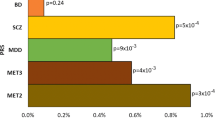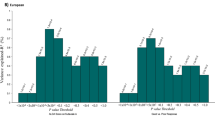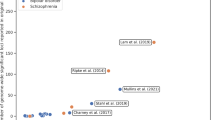ABSTRACT
Bipolar disorder (BD) is a major psychiatric condition that commonly requires prophylactic and episodic treatment. There is important variability in the therapeutic response and side-effect profiles to currently available pharmacological agents. Pharmacogenetics have provided new hopes to develop more efficient treatment strategies tailored to the individual patient's needs. This review assesses nonsystematically studies using pharmacogenetic strategies in BD. Most of these studies have focused on patients selected according to lithium response, and more recently, a growing number of studies have been investigating genetic factors in mixed samples of patients classified according to response to antidepressant treatment. Although previous clinical and family studies support the use of pharmacogenetic strategies both to increase phenotype homogeneity as well as to identify genetic factors that may mediate response to treatment, most molecular studies carried out to date are still preliminary and in need of external validation. A major problem has been comparability between studies, in part, because of differences in the criteria used to define response. More attention should be paid to standardize the criteria for drug response definition.
This is a preview of subscription content, access via your institution
Access options
Subscribe to this journal
Receive 6 print issues and online access
$259.00 per year
only $43.17 per issue
Buy this article
- Purchase on Springer Link
- Instant access to full article PDF
Prices may be subject to local taxes which are calculated during checkout

Similar content being viewed by others
References
Akiskal HS, Bourgeois ML, Angst J, Post R, Moller H, Hirschfeld R . Re-evaluating the prevalence of and diagnostic composition within the broad clinical spectrum of bipolar disorders. J Affect Disord 2000; 59: S5–S30.
APA. Diagnostic and Statistical Manual of Mental Disorders (DSM-IV), 4th edn. American Psychiatric Press: Washington, DC 1994.
Murray CJL, Lopez AD . The Global Burden of Disease. WHO: Geneva 1998.
Craddock N, Jones I . Molecular genetics of bipolar disorder. Br J Psychiatry Suppl 2001; 41: s128–s133.
Mansour HA, Alda M, Nimgaonkar VL . Pharmacogenetics of bipolar disorder. Curr Psychiatry Rep 2002; 4: 117–123.
Serretti A, Franchini L, Gasperini M, Rampoldi R, Smeraldi E . Mode of inheritance in mood disorder families according to fluvoxamine response. Acta Psychiatr Scand 1998; 98: 443–450.
Morissette J, Villeneuve A, Bordeleau L, Rochette D, Laberge C, Gagne B et al. Genome-wide search for linkage of bipolar affective disorders in a very large pedigree derived from a homogeneous population in Quebec points to a locus of major effect on chromosome 12q23–q24. Am J Med Genet 1999; 88: 567–587.
Schou M . Lithium Treatment of Manic-Depressive Illness A Practical Guide, 2nd edn. Basel: Karger 1983.
Lenox RH, Watson DG . Lithium and the brain: a psychopharmacological strategy to a molecular basis for manic depressive illness. Clin Chem 1994; 40: 309–314.
Schou M . Origin, Prevention and Treatment of Affective Disorders. Academic Press: London 1979.
Baraban JM, Worley PF, Snyder SH . Second messenger systems and psychoactive drug action: focus on the phosphoinositide system and lithium. Am J Psychiatry 1989; 146: 1251–1260.
Jope RS, Williams MB . Lithium and brain signal transduction systems. Biochem Pharmacol 1994; 47: 429–441.
Manji HK, Hsiao JK, Risby ED, Oliver J, Rudorfer MV, Potter WZ . The mechanisms of action of lithium. I. Effects on serotoninergic and noradrenergic systems in normal subjects. Arch Gen Psychiatry 1991; 48: 505–512.
Manji HK, Lenox RH . Lithium: a molecular transducer of mood-stabilization in the treatment of bipolar disorder. Neuropsychopharmacology 1998; 19: 161–166.
Risby ED, Hsiao JK, Manji HK, Bitran J, Moses F, Zhou DF et al. The mechanisms of action of lithium. II. Effects on adenylate cyclase activity and beta-adrenergic receptor binding in normal subjects. Arch Gen Psychiatry 1991; 48: 513–524.
Berridge MJ, Downes CP, Hanley MR . Neural and developmental actions of lithium: a unifying hypothesis. Cell 1989; 59: 411–419.
Coyle JT, Manji HK . Getting balance: drugs for bipolar disorder share target. Nat Med 2002; 8: 557–558.
Williams RS, Cheng L, Mudge AW, Harwood AJ . A common mechanism of action for three mood-stabilizing drugs. Nature 2002; 417: 292–295.
Gitlin MJ, Altshuler LL . Unanswered questions, unknown future for one of our oldest medications. Arch Gen Psychiatry 1997; 54: 21–23.
Goldberg JF, Garno JL, Leon AC, Kocsis JH, Portera L . A history of substance abuse complicates remission from acute mania in bipolar disorder. J Clin Psychiatry 1999; 60: 733–740.
Greil W, Kleindienst N, Erazo N, Muller-Oerlinghausen B . Differential response to lithium and carbamazepine in the prophylaxis of bipolar disorder. J Clin Psychopharmacol 1998; 18: 455–460.
Kusalic M, Engelsmann F . Predictors of lithium treatment responsiveness in bipolar patients. A two-year prospective study. Neuropsychobiology 1998; 37: 146–149.
Grof P, Alda M, Grof E, Fox D, Cameron P . The challenge of predicting response to stabilising lithium treatment. The importance of patient selection. Br J Psychiatry Suppl 1993: 16–19.
Mendlewicz J, Fieve RR, Stallone F, Fleiss JL . Genetic history as a predictor of lithium response in manic-depressive illness. Lancet 1972; 1: 599–600.
Mendlewicz J, Fieve RR, Stallone F . Relationship between the effectiveness of lithium therapy and family history. Am J Psychiatry 1973; 130: 1011–1013.
Zvolsky P, Vinarova E, Dostal T, Soucek K . Family history of manic-depressive and endogenous depressive patients and clinical effect of treatment with lithium. Act Nerv Super (Praha) 1974; 16: 194–195.
Prien RF, Caffey Jr EM, Klett CJ . Factors associated with treatment success in lithium carbonate prophylaxis. Report of the Veterans Administration and National Institute of Mental Health collaborative study group. Arch Gen Psychiatry 1974; 31: 189–192.
Maj M, Del Vecchio M, Starace F, Pirozzi R, Kemali D . Prediction of affective psychoses response to lithium prophylaxis. The role of socio-demographic, clinical, psychological and biological variables. Acta Psychiatr Scand 1984; 69: 37–44.
Smeraldi E, Petroccione A, Gasperini M, Macciardi F, Orsini A, Kidd KK . Outcomes on lithium treatment as a tool for genetic studies in affective disorders. J Affect Disord 1984; 6: 139–151.
Alda M, Grof P, Grof E, Zvolsky P, Walsh M . Mode of inheritance in families of patients with lithium-responsive affective disorders. Acta Psychiatr Scand 1994; 90: 304–310.
Grof P, Alda M, Grof E, Zvolsky P, Walsh M . Lithium response and genetics of affective disorders. J Affect Disord 1994; 32: 85–95.
Alda M, Grof E, Cavazzoni P, Duffy A, Martin R, Ravindran L et al. Autosomal recessive inheritance of affective disorders in families of responders to lithium prophylaxis? J Affect Disord 1997; 44: 153–157.
Engstrom C, Astrom M, Nordqvist K, Adolfsson R, Nylander PO . Relationship between prophylactic effect of lithium therapy and family history of affective disorders. Biol Psychiatry 1997; 42: 425–433.
Nylander PO, Engstrom C, Nordqvist-Karlsson B, Astrom M . Family history of affective disorders and the significance for prophylactic effect of lithium treatment. Biol Psychiatry 1999; 45: 1079–1081.
Coryell W, Akiskal H, Leon AC, Turvey C, Solomon D, Endicott J . Family history and symptom levels during treatment for bipolar I affective disorder. Biol Psychiatry 2000; 47: 1034–1042.
Grof P . Mood disorders—new definitions, treatment directions, and understanding. Can J Psychiatry 2002; 47: 123–124.
Passmore MJ, Garnham J, Duffy A, MacDougall M, Munro A, Slaney C et al. Phenotypic spectra of bipolar disorder in responders to lithium versus lamotrigine. Bipolar Disord 2003; 5: 110–114.
Mendlewicz J, Stallone F . Genetic factors and lithium response in manic-depressive illness. Mod Probl Pharmacopsychiatry 1975; 10: 23–29.
Coryell W, Akiskal H, Leon AC, Turvey C, Solomon D, Endicott J . Family history and symptom levels during treatment for bipolar I affective disorder. Biol Psychiatry 2000; 47: 1034–1042.
Grof P, Duffy A, Cavazzoni P, Grof E, Garnham J, MacDougall M et al. Is response to prophylactic lithium a familial trait? J Clin Psychiatry 2002; 63: 942–947.
Turecki G, Grof P, Grof E, D’Souza V, Lebuis L, Marineau C et al. Mapping susceptibility genes for bipolar disorder: a pharmacogenetic approach based on excellent response to lithium. Mol Psychiatry 2001; 6: 570–578.
Ewald H, Wang AG, Vang M, Mors O, Nyegaard M, Kruse TA . A haplotype-based study of lithium responding patients with bipolar affective disorder on the Faroe Islands. Psychiatr Genet 1999; 9: 23–34.
Freimer NB, Reus VI, Escamilla MA, McInnes LA, Spesny M, Leon P et al. Genetic mapping using haplotype, association and linkage methods suggests a locus for severe bipolar disorder (BPI) at 18q22–q23. Nat Genet 1996; 12: 436–441.
Turecki G, Grof P, Cavazzoni P, Duffy A, Grof E, Martin R et al. Lithium responsive bipolar disorder, unilineality, and chromosome 18: a linkage study. Am J Med Genet 1999; 88: 411–415.
Smith D, Chadwick D, Baker G, Davis G, Dewey M . Seizure severity and the quality of life. Epilepsia 1993; 34: S31–S35.
Normann C, Hummel B, Scharer LO, Horn M, Grunze H, Walden J . Lamotrigine as adjunct to paroxetine in acute depression: a placebo-controlled, double-blind study. J Clin Psychiatry 2002; 63: 337–344.
Klein PS, Melton DA . A molecular mechanism for the effect of lithium on development. Proc Natl Acad Sci USA 1996; 93: 8455–8459.
Williams RS, Harwood AJ . Lithium therapy and signal transduction. Trends Pharmacol Sci 2000; 21: 61–64.
Detera-Wadleigh SD . Lithium-related genetics of bipolar disorder. Ann Med 2001; 33: 272–285.
Jope RS, Bijur GN . Mood stabilizers, glycogen synthase kinase-3beta and cell survival. Mol Psychiatry 2002; 7: S35–S45.
Chen G, Huang LD, Jiang YM, Manji HK . The mood-stabilizing agent valproate inhibits the activity of glycogen synthase kinase-3. J Neurochem 1999; 72: 1327–1330.
Phiel CJ, Zhang F, Huang EY, Guenther MG, Lazar MA, Klein PS . Histone deacetylase is a direct target of valproic acid, a potent anticonvulsant, mood stabilizer, and teratogen. J Biol Chem 2001; 276: 36734–36741.
Harwood AJ, Agam G . Search for a common mechanism of mood stabilizers. Biochem Pharmacol 2003; 66: 179–189.
Lenox RH, Wang L . Molecular basis of lithium action: integration of lithium-responsive signaling and gene expression networks. Mol Psychiatry 2003; 8: 135–144.
Cavazzoni P, Alda M, Turecki G, Rouleau G, Grof E, Martin R et al. Lithium-responsive affective disorders: no association with the tyrosine hydroxylase gene. Psychiatry Res 1996; 64: 91–96.
Steen VM, Gulbrandsen AK, Eiken HG, Berle JO . Lack of genetic variation in the coding region of the myo-inositol monophosphatase gene in lithium-treated patients with manic depressive illness. Pharmacogenetics 1996; 6: 113–116.
Turecki G, Alda M, Grof P, Martin R, Cavazzoni PA, Duffy A et al. No association between chromosome-18 markers and lithium-responsive affective disorders. Psychiatry Res 1996; 63: 17–23.
Alda M, Grof P, Grof E . MN blood groups and bipolar disorder: evidence of genotypic association and Hardy–Weinberg disequilibrium. Biol Psychiatry 1998; 44: 361–363.
Turecki G, Grof P, Cavazzoni P, Duffy A, Grof E, Ahrens B et al. Evidence for a role of phospholipase C-gamma1 in the pathogenesis of bipolar disorder. Mol Psychiatry 1998; 3: 534–538.
Steen VM, Lovlie R, Osher Y, Belmaker RH, Berle JO, Gulbrandsen AK . The polymorphic inositol polyphosphate 1-phosphatase gene as a candidate for pharmacogenetic prediction of lithium-responsive manic-depressive illness. Pharmacogenetics 1998; 8: 259–268.
Serretti A, Lilli R, Lorenzi C, Franchini L, Smeraldi E . Dopamine receptor D3 gene and response to lithium prophylaxis in mood disorders. Int J Neuropsychopharmcol 1998; 1: 125–129.
Del Zompo M, Ardau R, Palmas MA, Bocchetta A, Reina A, Piccardi M . Lithium response: association study with two candidate genes. Mol Psychiatry 1999; 4: S66.
Turecki G, Alda M, Grof P, Joober R, Cavazzoni P, Duffy A et al. Polyglutamine tracts: no evidence of a major role in bipolar disorder. Mol Psychiatry 1999a; 4: 220–221.
Turecki G, Grof P, Cavazzoni P, Duffy A, Grof E, Ahrens B et al. MAOA: association and linkage studies with lithium responsive bipolar disorder. Psychiatr Genet 1999b; 9: 13–16.
Serretti A, Lilli R, Lorenzi C, Franchini L, Di Bella D, Catalano M et al. Dopamine receptor D2 and D4 genes, GABA(A) alpha-1 subunit genes and response to lithium prophylaxis in mood disorders. Psychiatry Res 1999a; 87: 7–19.
Serretti A, Lilli R, Lorenzi C, Gasperini M, Smeraldi E . Tryptophan hydroxylase gene and response to lithium prophylaxis in mood disorders. J Psychiatr Res 1999b; 33: 371–377.
Turecki G, Alda M, Grof P, Joober R, Lafreniere R, Cavazzoni P et al. Polyglutamine coding genes in bipolar disorder: lack of association with selected candidate loci. J Affect Disord 2000; 58: 63–68.
Duffy A, Turecki G, Grof P, Cavazzoni P, Grof E, Joober R et al. Association and linkage studies of candidate genes involved in GABAergic neurotransmission in lithium-responsive bipolar disorder. J Psychiatry Neurosci 2000; 25: 353–358.
Serretti A, Lorenzi C, Lilli R, Smeraldi E . Serotonin receptor 2A, 2C, 1A genes and response to lithium prophylaxis in mood disorders. J Psychiatr Res 2000; 34: 89–98.
Alda M, Turecki G, Grof P, Cavazzoni P, Duffy A, Grof E et al. Association and linkage studies of CRH and PENK genes in bipolar disorder: a collaborative IGSLI study. Am J Med Genet 2000; 96: 178–181.
Ftouhi-Paquin N, Alda M, Grof P, Chretien N, Rouleau G, Turecki G . Identification of three polymorphisms in the translated region of PLC-gamma1 and their investigation in lithium responsive bipolar disorder. Am J Med Genet 2001; 105: 301–305.
Lovlie R, Berle JO, Stordal E, Steen VM . The phospholipase C-gamma1 gene (PLCG1) and lithium-responsive bipolar disorder: re-examination of an intronic dinucleotide repeat polymorphism. Psychiatr Genet 2001; 11: 41–43.
Serretti A, Lilli R, Mandelli L, Lorenzi C, Smeraldi E . Serotonin transporter gene associated with lithium prophylaxis in mood disorders. Pharmacogenom J 2001a; 1: 71–77.
Serretti A, Lorenzi C, Lilli R, Mandelli L, Pirovano A, Smeraldi E . Pharmacogenetics of lithium prophylaxis in mood disorders: analysis of COMT, MAO-A, and Gbeta3 variants. Am J Med Genet 2002; 114: 370–379.
Walther DJ, Peter JU, Bashammakh S, Hortnagl H, Voits M, Fink H et al. Synthesis of serotonin by a second tryptophan hydroxylase isoform. Science 2003; 299: 76.
Sjoholt G, Molven A, Lovlie R, Wilcox A, Sikela JM, Steen VM . Genomic structure and chromosomal localization of a human myo-inositol monophosphatase gene (IMPA). Genomics 1997; 45: 113–122.
Sjoholt G, Gulbrandsen AK, Lovlie R, Berle JO, Molven A, Steen VM . A human myo-inositol monophosphatase gene (IMPA2) localized in a putative susceptibility region for bipolar disorder on chromosome 18p11.2: genomic structure and polymorphism screening in manic-depressive patients. Mol Psychiatry 2000; 5: 172–180.
Berrettini WH, Ferraro TN, Goldin LR, Detera-Wadleigh SD, Choi H, Muniec D et al. A linkage study of bipolar illness. Arch Gen Psychiatry 1997; 54: 27–35.
Zill P, Baghai TC, Zwanzger P, Schule C, Minov C, Riedel M et al. Evidence for an association between a G-protein beta3-gene variant with depression and response to antidepressant treatment. Neuroreport 2000; 11: 1893–1897.
Serretti A, Zanardi R, Rossini D, Cusin C, Lilli R, Smeraldi E . Influence of tryptophan hydroxylase and serotonin transporter genes on fluvoxamine antidepressant activity. Mol Psychiatry 2001c; 6: 586–592.
Serretti A, Zanardi R, Cusin C, Rossini D, Lorenzi C, Smeraldi E . Tryptophan hydroxylase gene associated with paroxetine antidepressant activity. Eur Neuropsychopharmacol 2001b; 11 (5): 375–380.
Mundo E, Walker M, Cate T, Macciardi F, Kennedy JL . The role of serotonin transporter protein gene in antidepressant-induced mania in bipolar disorder: preliminary findings. Arch Gen Psychiatry 2001; 58: 539–544.
Lin CN, Tsai SJ, Hong CJ . Association analysis of a functional G protein beta3 subunit gene polymorphism (C825T) in mood disorders. Neuropsychobiology 2001; 44: 118–121.
Kunugi H, Kato T, Fukuda R, Tatsumi M, Sakai T, Nanko S . Association study of C825T polymorphism of the G-protein b3 subunit gene with schizophrenia and mood disorders. J Neural Transm 2002; 109: 213–218.
Serretti A, Lorenzi C, Cusin C, Zanardi R, Lattuada E, Rossini D et al. SSRIs antidepressant activity is influenced by Gbeta3 variants. Eur Neuropsychopharmacol 2003; 13: 117–122.
Rasenick MM, Chaney KA, Chen J . G protein-mediated signal transduction as a target of antidepressant and antibipolar drug action: evidence from model systems. J Clin Psychiatry 1996; 57: 49–55.
Gould TD, Manji HK . Signaling networks in the pathophysiology and treatment of mood disorders. J Psychosom Res 2002; 53: 687–697.
Serretti A, Lorenzi C, Lilli R, Mandelli L, Pirovano A, Smeraldi E . Pharmacogenetics of lithium prophylaxis in mood disorders: analysis of COMT, MAO-A, and Gbeta3 variants. Am J Med Genet 2002; 114: 370–379.
Cusin C, Serretti A, Zanardi R, Lattuada E, Rossini D, Lilli R et al. Influence of monoamine oxidase A and serotonin receptor 2A polymorphisms in SSRI antidepressant activity. Int J Neuropsychopharmacol 2002; 5: 27–35.
Akiskal HS . Factors associated with incomplete recovery in primary depressive illness. J Clin Psychiatry 1982; 43: 266–271.
Pare CMB, Rees L, Sainsbury MJ . Differentiation of two genetically specific types of depression by the response to antidepressant. Lancet 1962; 280: 1340–1343.
Franchini L, Serretti A, Gasperini M, Smeraldi E . Familial concordance of fluvoxamine response as a tool for differentiating mood disorder pedigrees. J Psychiatr Res 1998; 32: 255–259.
Author information
Authors and Affiliations
Corresponding author
Additional information
DUALITY OF INTEREST
None declared.
Rights and permissions
About this article
Cite this article
Mamdani, F., Groisman, I., Alda, M. et al. Pharmacogenetics and bipolar disorder. Pharmacogenomics J 4, 161–170 (2004). https://doi.org/10.1038/sj.tpj.6500245
Received:
Revised:
Accepted:
Published:
Issue Date:
DOI: https://doi.org/10.1038/sj.tpj.6500245
Keywords
This article is cited by
-
Rare susceptibility variants for bipolar disorder suggest a role for G protein-coupled receptors
Molecular Psychiatry (2018)
-
No association between the PREP gene and lithium responsive bipolar disorder
BMC Psychiatry (2007)
-
The Pharmacogenetics of Lithium Response Depends upon Clinical Co-Morbidity
Molecular Diagnosis & Therapy (2007)



